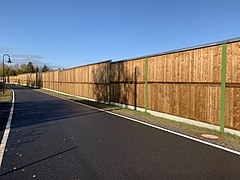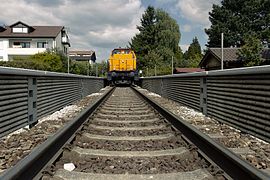Noise barrier

Noise protection walls and noise barriers are used to noise which originates from a line-shaped or flat sound source (eg. As roads , railways , factories ) to insulate , so that in a protected immission (eg. Residential buildings, hospitals) of the noise is weakened to such an extent that the legal limit values are observed. These can be supplemented by passive noise protection measures (e.g. soundproof windows ).
history
The first noise barriers were built in the USA in the mid-20th century because of the emergence of motorized traffic. In the late 1960s, a start was made to describe acoustic phenomena in connection with noise barriers using mathematical methods and thus to determine their effectiveness. This enabled better planning of new projects.
The Noise Pollution and Abatement Act of 1972 is considered to be an important step by the US in combating noise.
In order to protect the population from noise emissions, due to the Federal Immission Control Act, noise protection measures are required if the legal guide values are exceeded if the sound source is too strong. Affected residents can request appropriate expert reports or noise emission forecasts from their municipality.
Noise barriers are often installed on railway lines. Low-noise barriers are a newer innovation for noise protection on railway lines . Because of the way they work, low walls less than 50 cm high that are mounted directly next to the tracks are just as effective as high, more distant, traditional walls. Most of the noise in rail traffic is caused by the wheels (vibrations, creaking in curves, etc.).
Mode of action
Noise barriers have a noise-shielding effect; they partially prevent the sound from spreading . In this way, noise reductions of up to 20 dB (A) can be achieved. The effectiveness of a noise barrier as a sound screen depends on the following factors:
- Height of the noise barrier
- acoustic conception of the noise barrier
- Distance from the source of the noise (place of emission)
- Distance from the point of immission
- Height of the immission location
- Frequency spectrum of the sound
- Curvature of the wall
The following factors also influence the insulation effect:
- Reflections on opposite buildings or an opposite noise barrier can reduce the noise insulation. The reflected sound hits the wall or dam crest at a shallower angle, so that the dampening effect is no longer so great due to sound scattering. In addition, the reflected sound is added to the direct sound .
- Reflections on the floor can reduce the insulating effect. At the point of immission, the sound level is not only influenced by the direct sound from the wall or dam crest, but also by bumps in the ground , e.g. B. run along the surface. If the ground is noisy (e.g. asphalt), the bump can spread out well and increase the level. If the floor is sound-absorbing (e.g. forest floor), the level is lower.
- Weather conditions (wind, temperature stratification) can break the sound waves upwards or downwards .
- The sound path between the source and receiver around the obstacle is longer than the direct path, as the sound waves have to take a detour via the wall or dam crest. This leads to a level reduction due to the distance law .
- Diffraction effects on the upper edge reduce the effectiveness. The sound waves that hit the crest of the wall or dam are bent at it . As a result, the sound sometimes also reaches immission locations that are hidden behind the wall. The immission that reaches a receiver after crossing the crown depends on the angle by which the sound is deflected. The diffraction angle is frequency-dependent (it is smaller, the higher the frequency is). A simple model for taking these effects into account was presented by Meakawa in 1968 (→ see sound shadow ).
With Sound Screen Improvers (SSI) is an attempt to increase the efficiency of noise barriers. Generally, they are cylindrical or prismatic objects that are attached to the top of the wall. Due to the use of absorbent materials and their rounded shape (as opposed to the sharp edge), diffraction effects are reduced and a larger space behind the wall is protected from sound waves. Measurements by the ÖBB on a test track resulted in reductions in the sound level of 1.5 dB (A) to 5.5 dB (A) compared to the original state.
Unwanted side effects
Noise barriers
- can affect the cityscape and landscape and cut lines of sight .
- often block road users from seeing the landscape. This effect is particularly serious for rail travelers because noise barriers primarily obstruct the side view from the train window.
- are often sprayed with graffiti . In a statement by the city of Dinslaken , the fear was expressed that the affected areas would suffer a “trading down effect” as a result.
- can create secluded areas (e.g. at train stops ) that are beyond social control .
- can make access more difficult for emergency services and rescue workers in the event of a railway accident .
Greening and glass wall elements can mitigate urban development and landscape management impairments. However, the bird strike must be observed (see above). The above-mentioned Low noise barriers as well as measures on the vehicle and track are being considered.

variants
Sound barriers are made in a variety of materials and shapes. Sound-absorbing materials are advantageous because they particularly reduce the reflected and penetrating sound. These are particularly porous materials such as plastic.
The materials should have a long service life and be weatherproof. In the case of applications in the railway sector, it must also be taken into account that large pressure differences can arise as a result of high-speed trains passing by .
The different shapes and construction methods are mainly due to aesthetic reasons. Special curvatures or special upper edge shapes can make a significant contribution to increasing efficiency.
Different construction methods with materials are:
- Concrete walls are mainly used because of their long lifespan.
- Metals such as steel and aluminum are often used.
- Wood is CO 2 -neutral and integrates very well into the landscape. A long service life is guaranteed by modern wood protection.
- Glass is primarily used for aesthetic reasons. Windows in the wall should also break the monotony for the driver. However, the so-called bird strike problem must be taken into account here . H. then markings (e.g. strips) must be made on the glass or nets in front of it so that birds can recognize the glass and do not fly against it.
- Gabions are being used more and more in noise protection.
- Plastics or porous materials are used because of their good sound-insulating properties.
- Noise barriers can be built directly with the excavation during road construction and they can be integrated well into the landscape with plants. However, their effectiveness (noise level reduction in relation to height) is usually less than with walls and the space requirement is enormous.
Noise protection wall made of concrete elements on the high-speed railway line Ingolstadt – Nuremberg
Noise protection modules on the A 96 near Landsberg am Lech
Low noise protection wall on a railway line
Web links
- Chapter 7.1.6 Soundproofing . In: Urban noise primer online , published by the Baden-Württemberg Ministry of Economics, Labor and Housing, accessed on September 2, 2017
Individual evidence
- ↑ E. Hohnecker: Function-integrated noise protection measures on the rail track. (PDF; 3.4 MB). on: eisenbahn.ise.kit.edu .
- ↑ a b Measures to reduce noise from the noise action plan of the city of Leipzig. City of Leipzig
- ↑ Curved noise barriers are more effective. ( Memento from July 14, 2012 in the web archive archive.today ) on: ORF.at , August 28, 2007.
- ↑ ÖBB Infrastruktur Bau: Topic sheet noise protection solutions. on: oebb.at , March 2009.
- ↑ Railway fans demand a clear view of cities and landscapes! In: signal . 4, 2012.
- ↑ Statement of the city of Dinslaken on the plan approval procedure according to § 18 General Railway Act (AEG) for the ABS 46/2 border D / NL - Emmerich - Oberhausen regarding the three-track expansion and the removal of level crossings on route 2270 in plan approval section 1.3 Dinslaken dinslaken.de
- ↑ Cf. statements of the fire brigades in the Betuwe route safety working group on the plan approval decision of the Federal Railway Authority (EBA) for "ABS 46/2, three-track expansion and level crossing removal, plan approval section 1.1 (PFA 1.1)" in Oberhausen (Rhld.) From 18.11.2015. [1]
- ↑ B. Hofmeister: Noise barriers on high-speed rail lines - a challenge for lightweight construction. P. 2 ff. (PDF; 4.5 MB)












